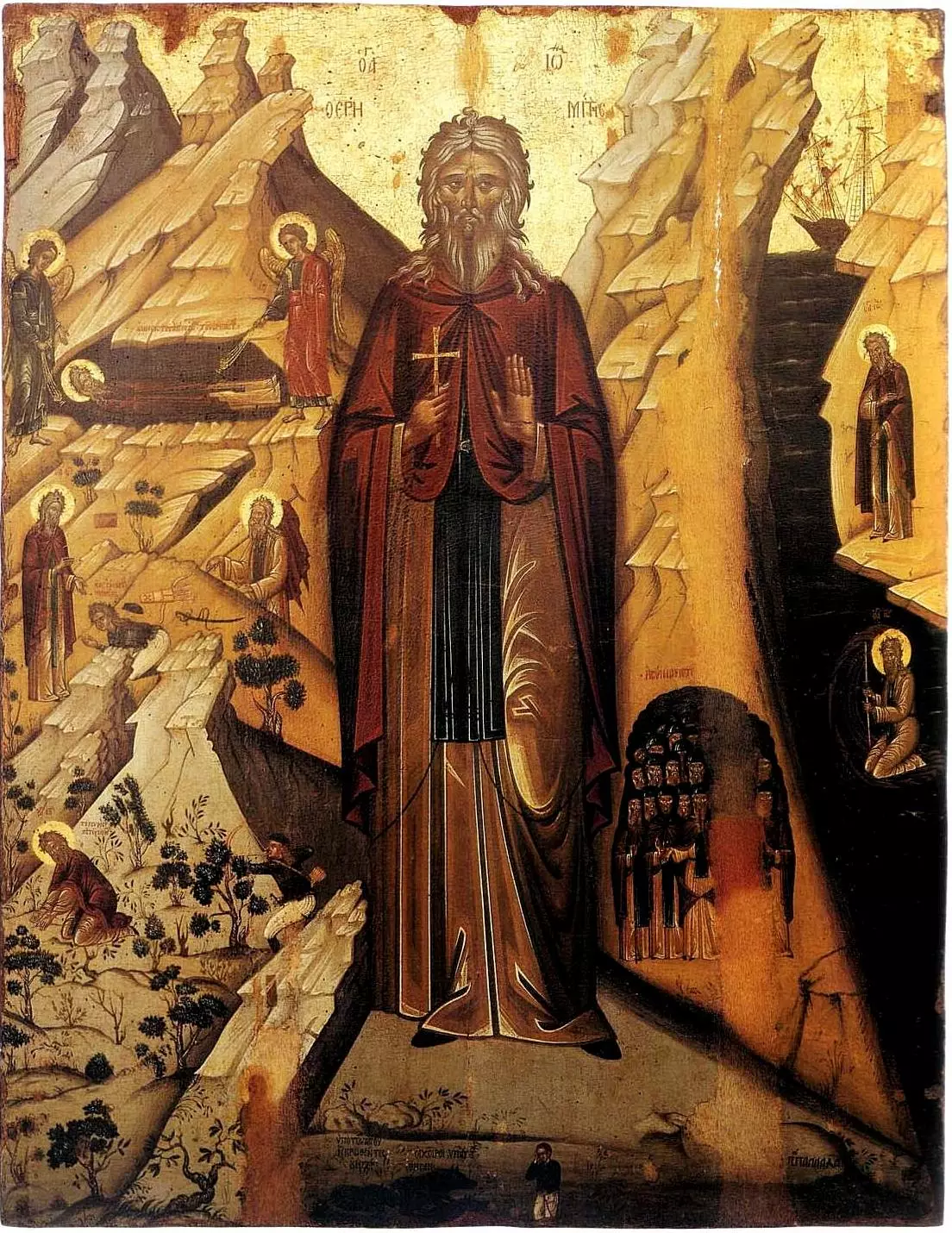
We see here a certain icon, not simply a religious offering, but a historical testimony. It is Saint John the Hermit, a work of the Cretan painter Ieremias Palladas, who flourished during the first half of the seventeenth century. This icon, made by the technique of egg tempera on wood and decorated with a gold ground, today in the Antivouniotissa Museum in Corfu is kept, having a measure of almost one cubit in width and a little more in height. And it depicts a certain man, a local hero of Crete, or rather saint, John by name, who chose the ascetic life in the mountains of that island around the beginning of the sixteenth century, when the island by the Venetians was held.
What then is this work? Assuredly it is an example of the so-called Cretan School, but in its later phase. This Palladas seems not wishing to innovate, but to the ancestral customs of Byzantine art adhering, in times of changes and of foreign influences from the West. This icon became a model for many of those who afterwards painted the same saint. For it combines the one, large, central figure of the saint—frontal and austere, as is proper—with many small scenes from his life, arranged around, just as a certain graphic narrative.
The Life of the Ascetic and the Art of Palladas
This figure, of John the Hermit, almost unknown is outside the borders of Crete. For he was a local saint, closely connected indeed with the spiritual life of the island, but his fame did not cross the Cretan sea. He lived, as is said, in solitude and great asceticism, far from the cities and the worldly turmoil, which the Venetian rule undoubtedly brought.
But the most paradoxical of all, and that which Palladas emphatically in the icon shows, is his death. For not by persecutors of the faith did he die, but from an accident, if indeed it is right so to call it. For it is said that a certain hunter, thinking him to be a wild beast in the darkness of the cave, shot him unwillingly. But the saint, before dying, forgave his killer. This scene of the shooting, to the left of the central figure depicted, became the main characteristic of his iconography. And it imparts to his figure something particular, almost tragic, beyond the usual sanctity.
The Cretan School and the Material
Palladas, as has been said, used the old technique. He remained faithful to the forms, the colours and the austerity of the Byzantine tradition, while other contemporaries of his were already beginning towards the Italian models to look. This persistence in the tradition was perhaps also a certain cultural stance, a resistance in the midst of the Venetocracy. And his work is not only a spiritual object, but also a material one, needing study. The contemporary researches on the pigment materials, which the Cretan painters used, reveal many things. The red hues, for example, those visible in the mantle of the saint, often came from kermes, a precious material then (Karapanagiotis and collaborators). And not only the colours, but also the organic materials, like the egg tempera, those binding the colours, bear witness to the technical prowess and the adherence to old methods (Valianou and collaborators). This art was complex, precise, almost scientific.
But let us return to the central figure. This one dominates the whole. John stands large, elderly, bearing a long white beard, looking straight towards the viewer. The stance is frontal, motionless, almost otherworldly. The attire, the red mantle over the black chiton, is typical of ascetics.
The Gaze and the Cross
His face is rendered with fine lines and careful shadings, according to the precise style of the Cretan School. The gaze is the centre. It is an austere gaze, but also compassionate, as if calling the worshipper into an immediate dialogue, a rare thing. And the right hand holds the cross, a symbol of faith but also of that martyrdom, the unwilling one, while the left blesses, or perhaps rather entreats, it is not clear. The detail of the hands is noteworthy, showing the draughtsmanly ability of Palladas.
And the setting? The local element is everywhere present. The gold ground indeed symbolises the divine light, the timeless, as always. But the rocky mountains, those surrounding the saint and the small scenes, these refer immediately to the rugged landscape of Crete, to the wilderness which he chose. Palladas here not only a saint paints, but also his place, his own homeland. This icon thus becomes not only a narrative of a life, but also a spiritual map of Crete of the seventeenth century. It is a document. A document powerful.
